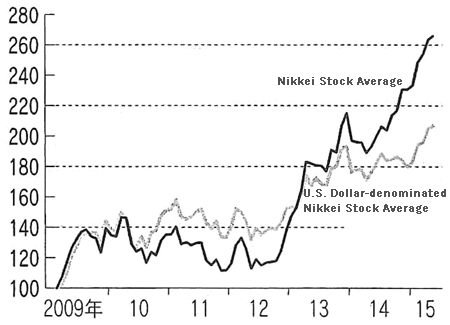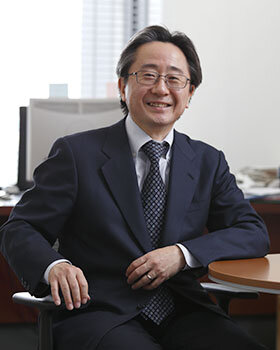Media Finance and the Social Security System 2015.06.10
Does the Nikkei Stock Average of 20,000 Reflect the True State of Affairs? Japanese companies' earning power is still on its way to recovery
The Nikkei Stock Average closed above 20,000 yen on April 22, 2015 for the first time in 15 years since April 14, 2000. Has the Japanese economy finally emerged from prolonged deflation? Has the structure of the business community changed? Does the recovery of stock prices signify that Japanese companies have regained their earning power?
My understanding is that there is concern about future risks at the macroeconomic level, and there is hope for structural changes at the microeconomic level or at the level of companies.
First, let's take a look at macroeconomic issues. Owing to a weaker yen, exporting companies were able to report a significant increase in yen-denominated terms even when their export volume remained unchanged. If we subtract a portion of the rise in stock prices attributable to the effect of a weaker yen, the average price of 20,000 yen does not necessarily reflect the true earning power of Japanese companies. A significant portion of the rise in the Nikkei Stock Average is eroded in U.S. dollar-denominated terms (see Figure).
Figure: Nikkei Stock Average and U.S. Dollar-denominated Nikkei Stock Average

Note: Indexed with February 2009 = 100, using the closing price on the first trading day of each month, with the closing price on April 22, 2015 added after that of April 1, 2015.
Furthermore, from a long-term viewpoint, uncertainty over Japan's fiscal sustainability and macroeconomic stability remains a significant source of concern. The occurrence of a fiscal crisis (price adjustments by means of hyperinflation) would blow away whatever might have been achieved through efforts by individual companies.
Partly due to lessons learned from the Japanese banking crisis in the late 1990s and the global financial crisis following the collapse of Lehman Brothers in 2008, Japanese companies continue to show a strong preference for high liquidity. Strong risk aversion may be a rational choice for individual companies but inhibits macroeconomic growth. This is a typical case of the fallacy of composition.
However, there is no resolving the risk-averse behavior of companies without dispelling the uncertainty over Japan's fiscal sustainability in the future. Raising the consumption tax rate to 10% would be far from enough to ensure fiscal stability. Meanwhile, fiscal austerity and a consumption tax rate hike would dampen the economy. In terms of macroeconomic management and fiscal policy, Japan is walled in all sides with no way out.
Doing nothing but urging companies to take risks to grow under this situation is unreasonable. In order to help dispel the uncertainty of the future, the government should release its fiscal projections for the next 40 years to provide reasonable fiscal consolidation options from which taxpayers can choose.
On the other hand, I am more hopeful about microeconomic developments.
In February 2014, Japan's Stewardship Code, which sets forth a code of conduct for institutional investors as shareholders, was established, while a corporate governance code is slated for introduction in June 2015. Japanese corporate governance is beginning to change. The key characteristic of the ongoing governance evolution is a move to change the flow of capital from investors to business corporations (investment chain) in entirety. Corporate governance reform used to be centered on the reform of organizational structure within each business corporation as an investee. This time around, reform on the side of institutional investors has been brought into focus.
Changes in the return on equity (ROE) of Japanese companies over time suggest that the relationship between investors in Japanese stocks and investee companies is problematic. The 10-year average ROE of Japanese stocks (in the 2000s) was about 6%, roughly half of the global average.
The recent rise in the Nikkei Stock Average to beyond 20,000 has been acclaimed as having been driven by companies with high ROE. However, short-term ROE should not be taken as a target for business management. ROE is a proxy variable of productivity and should be evaluated in terms of long-term value.
The real issue here is the productivity of Japanese companies. For more than 20 years, Japan's total factor productivity (TFP) growth rate has remained close to zero, and the low ROE of Japanese companies is a reflection of their low productivity. When measured in terms of an equity spread, which is defined as a difference between ROE and the cost of equity, the low productivity of Japanese companies all the more stands out.
The establishment of the corporate governance code and other measures set forth in the government's Japan Revitalization Strategy 2014 are an attempt to rectify the weakness of the Japanese corporate governance system so as to enhance the country's overall productivity and economic growth.
The key problem with the Japanese corporate governance system is its failure to transition properly from the traditional governance model where creditor banks play the key monitoring role (bank-oriented governance) to a new model in which shareholders fulfill that role (shareholder-oriented governance). The bank-oriented governance mechanism, which worked effectively up until the 1970s when Japanese companies were short of funds, has been weakened significantly amid excess liquidity following the burst of the bubble economy. However, the shareholder-oriented governance mechanism, which should be taking over the role, has not been functioning effectively.
Problems exist not only on the side of business corporations as the issuers of stocks, but also on the side of stockholders (institutional investors such as asset management firms) that are not necessarily effective as governing bodies. Japanese asset management firms are characteristic in that they invest a large proportion of managed assets in short-term investments, which would not involve any intervention in investees' management for improvement. A certain percentage of those asset management firms need to become committed to long-term engagement. In other words, it is necessary to promote an investment model in which investors seek to gain return from long-term growth in investee companies by closely engaging with and improving their management.
For that, end investors (pension funds, life insurance companies, etc.) that entrust their funds with asset management firms also need to become committed to long-term engagement. Furthermore, there should be a greater number of like-minded asset management firms entering the market. All of the players involved in the investment chain--issuers, asset managers, end investors--need to change, and various policy measures should be implemented to facilitate that process. For further detail, readers are advised to refer to ROE Saihinkoku Nihon o Kaeru [Change Japan, a Country with the Lowest ROE] compiled by Yama o Ugokasu Kenkyukai, a private research team established three years ago by a group of researcher including myself.
Management reform for ROE improvement tends to be viewed as a zero-sum game that would benefit shareholders at the cost of workers. In order to realize a positive-sum game, thereby boosting not only ROE but also employment and wages, labor market reform must be carried out in tandem with management reform in an integrated manner.
An example of a positive-sum game can be found in an unexpected place. A senior executive of Toyota Motor Corporation, a leading high-ROE, once told me that the underlying essence of the Toyota Production System is respect for humanity. According to him, the Toyota Production System improves productivity by enhancing employees' sense of participation in their respective workplace and putting into practice various workplace improvement ideas voluntarily proposed by them.
This philosophy is in tune with the concept of positive liberty that has been passed down throughout human history. Unlike that in the fields of political science and political thought, the difference between positive liberty and negative liberty is hardly recognized in economic debates. The liberty to choose from given options is negative liberty or the freedom of choice. When economics discusses liberty or freedom, it is, without exception, talking about negative liberty.
On the other hand, according to Harvard University Professor Michael Sandel, freedom (positive liberty) in classical political philosophy has always been freedom or liberty to participate in self-governance since the time of ancient Greece. For citizens in ancient Greece, being able to participate and make decisions for themselves in the politics of their polis, or city state, was the essential element of liberty and an irreplaceable value. The same holds true for various organizations and teams (local governments, corporations, civic groups, etc.) that we see today.
In the case of business corporations, giving employees the freedom to decide for their own workplace would bring a sense of satisfaction to the employees. At the same time, it would inevitably generate a strong sense of responsibility for the team to which they belong, resulting in a significant boost in the team's productivity. One leading example that has taken the fullest advantage of such nature of positive liberty to improve productivity successfully is the Toyota Production System.
We can probably say that companies that are capable of remaining competitive for a long time are those in which all stakeholders have positive liberty to participate in decision-making with a sense of ownership. Whether Japanese companies can achieve a long-term ROE success hinges on whether they are capable of such management. The prospective corporate governance code calls on companies to give due consideration to stakeholders as part of their efforts to increase corporate values. The entire spectrum of the investment chain, including investors, must change. It is hoped that the ongoing boom in the stock market will serve as a catalyst for bringing about such changes.
*Translated by the Research Institute of Economy, Trade and Industry (RIETI) from the original Japanese Keizai Kyoshitsu column in the April 28, 2015 issue of Nihon Keizai Shimbun. Reproduced with permission.
>> Original text in Japanese
